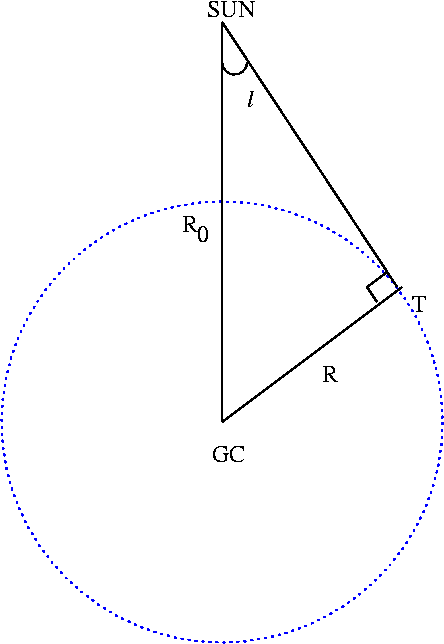An dynamically interesting
quantity to measure is the rotation curve of the Galaxy: how the circular
velocity varies as a function of radius in the Milky Way.
In principle, this should be posible using the radial velocities and proper motions of stars in the disk of our Galaxy (as we already discussed). However, the light of stars in the disk is strongly absorbed by dust.
We can however, use the HI gas which emits in the radio and is not affected by dust.
The problem in this case is that it is usually impossible to know the distance to the emitting gas.
For the inner Galaxy (R < R0) we can use the tangent-point method.
This method uses the fact that the angular speed decreases with radius. For a given direction with 0 < l < 90, the line of sight velocity is greatest at the tangent point T,
where the line of sight direction is perpendicular to the vector to the Galactic centre,
and hence this line of sight is parallel to the tangential velocity at that point, which is
just the circular velocity.

Thus we have for the tangent point:
RT = R0 sin l
and
Vlos = R0 sin l (VT/RT - V0/R0) = VT - V0 sin l -> VT = V0 sin l + Vlos
In principle, this should be posible using the radial velocities and proper motions of stars in the disk of our Galaxy (as we already discussed). However, the light of stars in the disk is strongly absorbed by dust.
We can however, use the HI gas which emits in the radio and is not affected by dust.
The problem in this case is that it is usually impossible to know the distance to the emitting gas.
For the inner Galaxy (R < R0) we can use the tangent-point method.
This method uses the fact that the angular speed decreases with radius. For a given direction with 0 < l < 90, the line of sight velocity is greatest at the tangent point T,
where the line of sight direction is perpendicular to the vector to the Galactic centre,
and hence this line of sight is parallel to the tangential velocity at that point, which is
just the circular velocity.

Thus we have for the tangent point:
RT = R0 sin l
and
Vlos = R0 sin l (VT/RT - V0/R0) = VT - V0 sin l -> VT = V0 sin l + Vlos